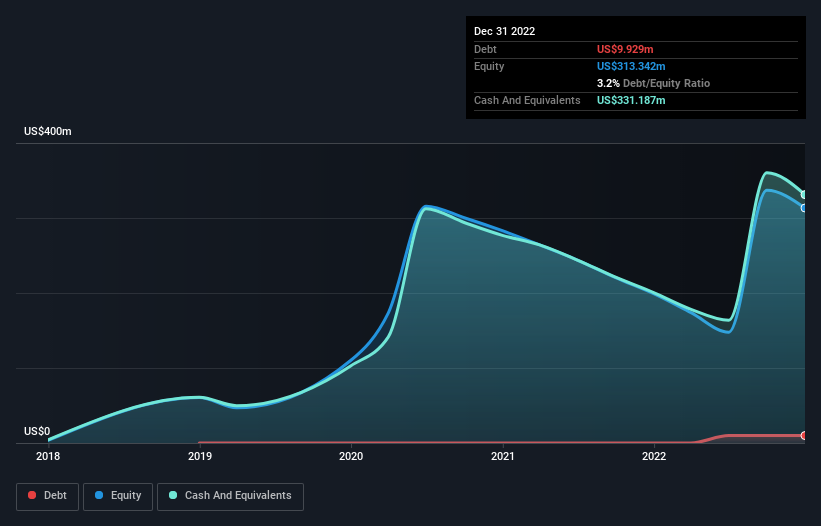- United States
- /
- Pharma
- /
- NasdaqGS:PLRX
Health Check: How Prudently Does Pliant Therapeutics (NASDAQ:PLRX) Use Debt?

The external fund manager backed by Berkshire Hathaway's Charlie Munger, Li Lu, makes no bones about it when he says 'The biggest investment risk is not the volatility of prices, but whether you will suffer a permanent loss of capital.' When we think about how risky a company is, we always like to look at its use of debt, since debt overload can lead to ruin. We note that Pliant Therapeutics, Inc. (NASDAQ:PLRX) does have debt on its balance sheet. But the more important question is: how much risk is that debt creating?
When Is Debt A Problem?
Debt and other liabilities become risky for a business when it cannot easily fulfill those obligations, either with free cash flow or by raising capital at an attractive price. In the worst case scenario, a company can go bankrupt if it cannot pay its creditors. While that is not too common, we often do see indebted companies permanently diluting shareholders because lenders force them to raise capital at a distressed price. Of course, the upside of debt is that it often represents cheap capital, especially when it replaces dilution in a company with the ability to reinvest at high rates of return. When we think about a company's use of debt, we first look at cash and debt together.
View our latest analysis for Pliant Therapeutics
What Is Pliant Therapeutics's Net Debt?
The image below, which you can click on for greater detail, shows that at December 2022 Pliant Therapeutics had debt of US$9.93m, up from none in one year. But it also has US$331.2m in cash to offset that, meaning it has US$321.3m net cash.

How Healthy Is Pliant Therapeutics' Balance Sheet?
According to the last reported balance sheet, Pliant Therapeutics had liabilities of US$23.9m due within 12 months, and liabilities of US$13.4m due beyond 12 months. On the other hand, it had cash of US$331.2m and US$3.14m worth of receivables due within a year. So it can boast US$297.1m more liquid assets than total liabilities.
It's good to see that Pliant Therapeutics has plenty of liquidity on its balance sheet, suggesting conservative management of liabilities. Given it has easily adequate short term liquidity, we don't think it will have any issues with its lenders. Simply put, the fact that Pliant Therapeutics has more cash than debt is arguably a good indication that it can manage its debt safely. When analysing debt levels, the balance sheet is the obvious place to start. But it is future earnings, more than anything, that will determine Pliant Therapeutics's ability to maintain a healthy balance sheet going forward. So if you want to see what the professionals think, you might find this free report on analyst profit forecasts to be interesting.
In the last year Pliant Therapeutics wasn't profitable at an EBIT level, but managed to grow its revenue by 28%, to US$9.7m. Shareholders probably have their fingers crossed that it can grow its way to profits.
So How Risky Is Pliant Therapeutics?
Statistically speaking companies that lose money are riskier than those that make money. And in the last year Pliant Therapeutics had an earnings before interest and tax (EBIT) loss, truth be told. And over the same period it saw negative free cash outflow of US$96m and booked a US$123m accounting loss. With only US$321.3m on the balance sheet, it would appear that its going to need to raise capital again soon. Pliant Therapeutics's revenue growth shone bright over the last year, so it may well be in a position to turn a profit in due course. By investing before those profits, shareholders take on more risk in the hope of bigger rewards. There's no doubt that we learn most about debt from the balance sheet. But ultimately, every company can contain risks that exist outside of the balance sheet. These risks can be hard to spot. Every company has them, and we've spotted 5 warning signs for Pliant Therapeutics (of which 2 can't be ignored!) you should know about.
Of course, if you're the type of investor who prefers buying stocks without the burden of debt, then don't hesitate to discover our exclusive list of net cash growth stocks, today.
If you're looking to trade Pliant Therapeutics, open an account with the lowest-cost platform trusted by professionals, Interactive Brokers.
With clients in over 200 countries and territories, and access to 160 markets, IBKR lets you trade stocks, options, futures, forex, bonds and funds from a single integrated account.
Enjoy no hidden fees, no account minimums, and FX conversion rates as low as 0.03%, far better than what most brokers offer.
Sponsored ContentNew: Manage All Your Stock Portfolios in One Place
We've created the ultimate portfolio companion for stock investors, and it's free.
• Connect an unlimited number of Portfolios and see your total in one currency
• Be alerted to new Warning Signs or Risks via email or mobile
• Track the Fair Value of your stocks
Have feedback on this article? Concerned about the content? Get in touch with us directly. Alternatively, email editorial-team (at) simplywallst.com.
This article by Simply Wall St is general in nature. We provide commentary based on historical data and analyst forecasts only using an unbiased methodology and our articles are not intended to be financial advice. It does not constitute a recommendation to buy or sell any stock, and does not take account of your objectives, or your financial situation. We aim to bring you long-term focused analysis driven by fundamental data. Note that our analysis may not factor in the latest price-sensitive company announcements or qualitative material. Simply Wall St has no position in any stocks mentioned.
About NasdaqGS:PLRX
Pliant Therapeutics
A biopharmaceutical company, discovers, develops, and commercializes novel therapies for the treatment of fibrosis and related diseases.
Excellent balance sheet slight.
Market Insights
Community Narratives



